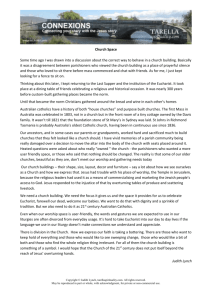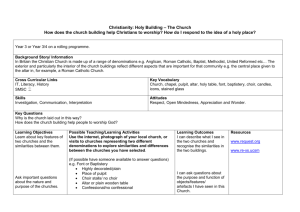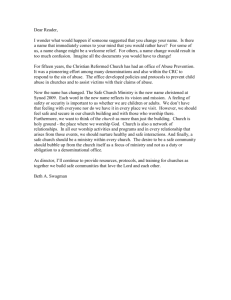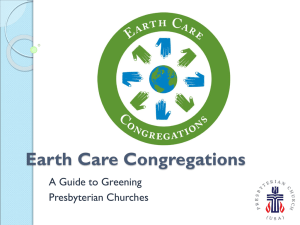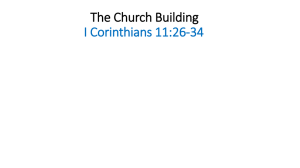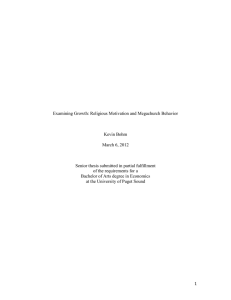New Ways of Being Big - Hartford Institute for Religion Research
advertisement
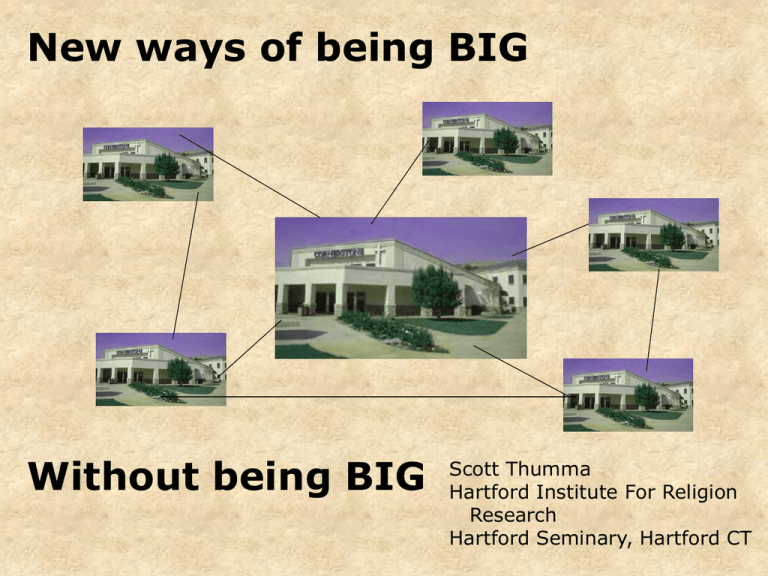
New ways of being BIG Without being BIG Scott Thumma Hartford Institute For Religion Research Hartford Seminary, Hartford CT The goal •less overhead •less infrastructure costs •less conflict with the community •less duplication of effort •less impulse to build •big in resources •big in impact •big in ministry activities •big in influence •big in the Kingdom And Spirit-led Creativity The Internet is the model little overhead, shared resources, interconnected nodes, customizable, and yet a major influence. All megachurches do this out of necessity. A Very Large Church is: • Costly – higher price to build. • An Encumbrance – higher cost to maintain. • Conflictual – creates battles with local neighbors, city, and the environment. • A Challenge – to keep filled. THE FACTS Just because a congregation attains several thousand in worship does not mean it has a large sanctuary. The median (midpoint of the range – meaning 50% were below and 50% above this figure) seating capacity of the largest worship service was 1,400. Only 5% of megachurches have sanctuaries of 3,000 seats or more. 53% of churches hold four or more services over two or three days. Nearly all (97%) megachurches hold multiple worship services, with 5% holding 9 or more each weekend. A majority of megachurches felt they had insufficient building space for their ministries. These churches have found other ways of creating enough seating for those who want to attend. At least 50% of churches use multiple venues for worship as well as satellite locations to increase seating capacity. Half of these say the multiple services are somewhat or very different in style from their main worship service. Over a third of churches (37%) helped plant at least one new congregation in the past 5 years. Twenty-seven percent of megachurches hold services at satellite locations (up 5% in 5 years) and another 27% are considering doing this. Of this group with multi-site locations, three quarters have just one or two additional locations, but 10% have more than 5 separate locations. Twenty-two percent of congregations claimed to have started a satellite or offsite campus since 2000. 34% employ a multiple venue worship service format where these services with distinctive styles and focus are held simultaneously in buildings on their main campus. Alternatives Multiple worship services Venue worship services Church planting Multiple campuses Using existing buildings Networking of like-minded churches Multiple Worship Services Pros •less need to build larger buildings to accommodate everyone •give your best leaders practice at leading worship Cons •increases the load on the senior minister •increases work load for staff doing multiple services •provide flexibility of service times •makes service times rigid – in and out, less flexibility or lingering •tailors the services to suit different interests, subcultural groups •less interpersonal interaction with whole congregation, maybe clichés form •perhaps decreased attendance when senior minister isn’t preaching Venue Worship Services Pros •tailors the venues to suit different interests, sub cultural groups Cons •Can divide your congregation into clichés or sub-groups •provide flexibility of service times •increases need for more staff doing multiple services at the same time •give your best leaders practice at leading worship •less impact than with one huge congregation •decreased work load on senior minister •the senior minister is only viewed through the screen •less need to build larger buildings to accommodate everyone •complex technological challenges in broadcasting sermon Church Planting Pros • give your best leaders their own congregations Cons • little control over pastor’s vision • allow them to grow in own directions • duplicating of work load due to running the many churches separately • enable new ministries to tailor to new areas • less impact than with one huge congregation • reduce load on senior minister • considerable cost and risk in getting planted churches to thrive • enhance church reach into other parts of the country • harder to keep in contact with daughter churches Multiple Site Campuses Over a third of megachurches are Multi-site Multiple Site Campuses Pros • give your best leaders their own congregations • allow them to grow in own directions • enable new ministries to tailor to new areas Cons • Can divide your congregation into sub-groups by areas of the city • need for duplicating efforts throughout the city • less impact than with one huge congregation • reduce load on senior minister • the senior minister is only viewed through the screen • Less congestion and pressure on the main campus • complex technological challenges in broadcasting sermon • Less driving for members Using Existing Buildings An old idea going in new directions Storefront churches •Mall spaces •School spaces •Existing Churches •Hotels •Businesses •Stadiums •Movie theaters National Community Church meets in the Regal Theaters located on the 4th floor at Ballston Common Mall. National Community Church meets in the movie theaters at Union Station Networking of Like-Minded Churches Network with smaller churches to: address large community & national issues be supportive of other clergy create alliances share resources educate and instruct each other influence religious trends in place of or in addition to national denominations In 2000 – 20% of megachurches belonged to a Network, Fellowship or Association of churches A large presence does not require a large building only a large vision.

